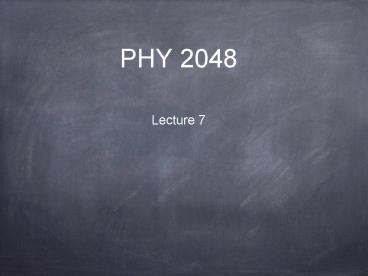PHY 2048 PowerPoint PPT Presentation
1 / 14
Title: PHY 2048
1
PHY 2048
- Lecture 7
2
CHAPTER 11
Equlibrium (11.1, 11.2, 11.3)
3
Equilibrium conditions for a rigid body
First condition Net external force acting on
its center of mass is zero
Second condition Net torque about any point due
to all the external forces is zero
4
There is a force due to gravity on each mass
(weight)
Net torque about O due to gravity is
The net torque about an objects center of mass
is zero
5
A nonuniform, horizontal bar of mass m is
supported by two massless wires against gravity.
The left wire makes an angle F1 with the
horizontal, and the right wire makes an angle F2.
The bar has length L.
Forces on the bar
Conditions for equilibrium
1) Net force in the horizontal direction has to
be zero
2) Net force in the vertical direction has to be
zero
3) Net torque about any point has to be zero. We
take it counter-clockwise about an axis going
through the center of mass and coming out of the
plane
Only the vertical components of the tension
contribute to the torque
6
CHAPTER 13
Gravitation
7
Newtons law of Gravitation
Free fall is caused by Newtons law of gravitation
r for a free falling body is for all practical
purposes the radius of the earth, RE 6380 km.
mE 5.974 X 1024 kg
8
Neutron stars, such as the one at the center of
the Crab Nebula, have about the same mass as our
sun but a much smaller diameter.
If you weigh 665 N on earth, what is your weight
on the surface of a neutron star?
Assume Mass of the neutron star is the same as
our sun, namely, 1.99 x 1030 kg
Assume the diameter of the neutron star is 19.0 km
G6.67 X 10-11 N m2/kg2
Your mass is 665/9.81 kg 67.8 kg
Acceleration due to gravity on the surface of the
neutron star is
Your weight on the surface of the neutron star
is 67.8 x (1.47 x 1012) 9.97 x 1013 N
9
Gravitational potential energy
Gravitational force is conservative force
Let U(r) be the potential energy at a distance r
from the center of one of the masses
Taking the attractive sign into account
Refer to slide 11 of lecture 4
For an object at a height h above the surface of
the earth
10
Escape velocity
What should be the lift off speed of a rocket to
escape earths gravity and go off to infinity?
Gravity is a conservative force
Let r be the distance of the rocket from the
center of the earth
Let v(r) be the speed of the rocket when it is a
distance r from the center of the earth
Let m be the mass of the rocket
The rockets kinetic energy is (1/2)mv2(r)
The rockets gravitational potential energy is
-(GmEm)/r
The total energy of the rocket equal to
(1/2)mv2(r) -(GmEm)/r must be a constant
If the rocket were to barely escape earths
gravity, its kinetic energy at infinite distance
from the center of the earth will be zero.
The gravitational potential energy at infinite
distance is also zero.
The total energy must be zero for the rocket at
any distance r
11.2 km/s
11
Circular Orbits - Uniform Circular Motion
Refer to slide 4, lecture 3
T is the period, namely, the time to complete one
orbit
Gravitational force is the cause for this
acceleration
Total energy of the satellite is
12
Can the asteroid hit the earth?
Let us take the center of the earth as the origin
of our coordinate system.
We will assume that the asteroid and the earth
form an isolated system and no external forces
act on this system.
Total energy of the asteroid must be a constant
as it moves
Total energy far far away from the earth is 1/2
mv2 since the gravitational potential energy is
zero.
Total energy at the time of impact is 1/2 mvf2 -
GMem/R
Conservation of total energy
Conservation of angular momentum
13
Keplers laws
14
Elliptic orbits
Let M be the mass of the sun and m be the mass of
the planet
Pick the sun to be the origin of the coordinate
system
The total energy of the planet, E, is a constant
as it moves
The total angular momentum, L, of the planet
about an axis passing through the sun and
perpendicular to the plane of the orbit is a
constant as the planet moves
Let the subscript e stand for both p and a
Elt0 since the planet is in orbit
The two roots of the quadratic equation
correspond to the perihelion and aphelion

